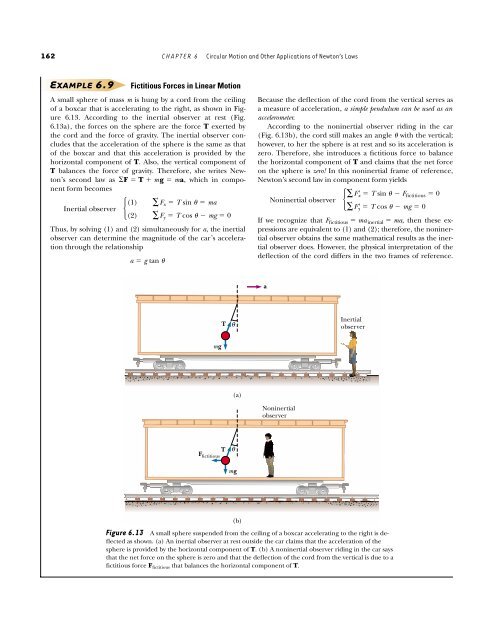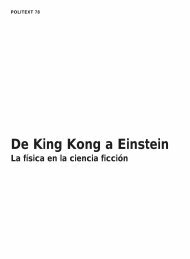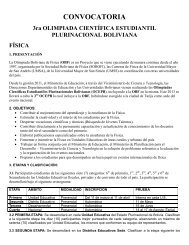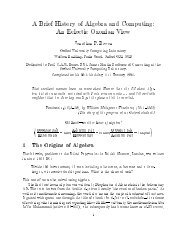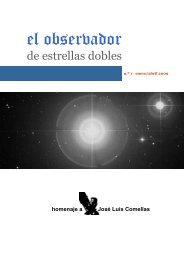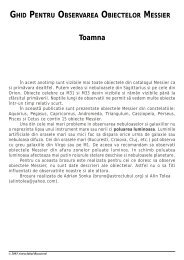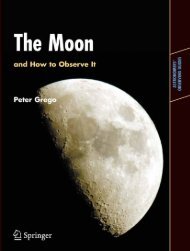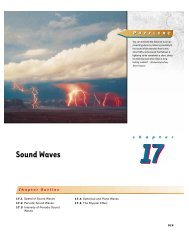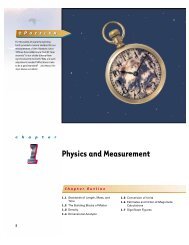Circular Motion and Other Applications of Newton's Laws
Circular Motion and Other Applications of Newton's Laws
Circular Motion and Other Applications of Newton's Laws
Create successful ePaper yourself
Turn your PDF publications into a flip-book with our unique Google optimized e-Paper software.
162 CHAPTER 6 <strong>Circular</strong> <strong>Motion</strong> <strong>and</strong> <strong>Other</strong> <strong>Applications</strong> <strong>of</strong> Newton’s <strong>Laws</strong><br />
EXAMPLE 6.9<br />
Fictitious Forces in Linear <strong>Motion</strong><br />
A small sphere <strong>of</strong> mass m is hung by a cord from the ceiling<br />
<strong>of</strong> a boxcar that is accelerating to the right, as shown in Figure<br />
6.13. According to the inertial observer at rest (Fig.<br />
6.13a), the forces on the sphere are the force T exerted by<br />
the cord <strong>and</strong> the force <strong>of</strong> gravity. The inertial observer concludes<br />
that the acceleration <strong>of</strong> the sphere is the same as that<br />
<strong>of</strong> the boxcar <strong>and</strong> that this acceleration is provided by the<br />
horizontal component <strong>of</strong> T. Also, the vertical component <strong>of</strong><br />
T balances the force <strong>of</strong> gravity. Therefore, she writes Newton’s<br />
second law as �F � T � mg � ma, which in component<br />
form becomes<br />
�<br />
(1) �Fx � T sin � � ma<br />
Inertial observer<br />
(2) �Fy � T cos � � mg � 0<br />
Thus, by solving (1) <strong>and</strong> (2) simultaneously for a, the inertial<br />
observer can determine the magnitude <strong>of</strong> the car’s acceleration<br />
through the relationship<br />
a � g tan �<br />
mg<br />
T<br />
T<br />
F fictitious<br />
θ<br />
θ<br />
mg<br />
(a)<br />
(b)<br />
Because the deflection <strong>of</strong> the cord from the vertical serves as<br />
a measure <strong>of</strong> acceleration, a simple pendulum can be used as an<br />
accelerometer.<br />
According to the noninertial observer riding in the car<br />
(Fig. 6.13b), the cord still makes an angle � with the vertical;<br />
however, to her the sphere is at rest <strong>and</strong> so its acceleration is<br />
zero. Therefore, she introduces a fictitious force to balance<br />
the horizontal component <strong>of</strong> T <strong>and</strong> claims that the net force<br />
on the sphere is zero! In this noninertial frame <strong>of</strong> reference,<br />
Newton’s second law in component form yields<br />
Noninertial observer<br />
� �F� x � T sin � � F fictitious � 0<br />
�F� y � T cos � � mg � 0<br />
If we recognize that F fictitious � ma inertial � ma, then these expressions<br />
are equivalent to (1) <strong>and</strong> (2); therefore, the noninertial<br />
observer obtains the same mathematical results as the inertial<br />
observer does. However, the physical interpretation <strong>of</strong> the<br />
deflection <strong>of</strong> the cord differs in the two frames <strong>of</strong> reference.<br />
a<br />
Noninertial<br />
observer<br />
Inertial<br />
observer<br />
Figure 6.13 A small sphere suspended from the ceiling <strong>of</strong> a boxcar accelerating to the right is deflected<br />
as shown. (a) An inertial observer at rest outside the car claims that the acceleration <strong>of</strong> the<br />
sphere is provided by the horizontal component <strong>of</strong> T. (b) A noninertial observer riding in the car says<br />
that the net force on the sphere is zero <strong>and</strong> that the deflection <strong>of</strong> the cord from the vertical is due to a<br />
fictitious force F fictitious that balances the horizontal component <strong>of</strong> T.


